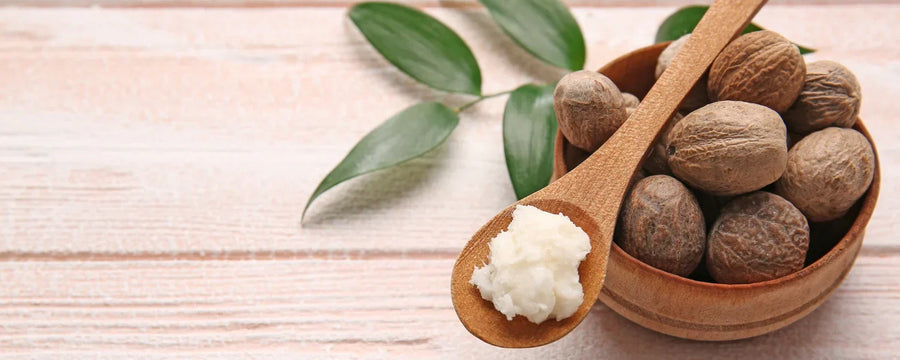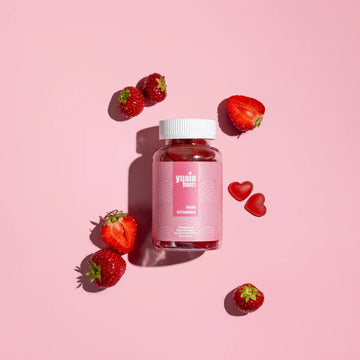

Read through by Dorthe Kristensen
Hairdresser and former co-owner of the award-winning hairdressing chain Zoom by Zoom
With many years of experience in the hairdressing industry, Dorthe has advised many customers about hair and hair care. Dorthe has read through this blog entry to ensure high quality and professionalism. This blog post is professionally updated on April 5, 2025.
Table of contents
Shea butter, derived from the nuts of the African shea tree, has long been celebrated for its remarkable skincare properties. In recent years, it has gained significant popularity within the hair care industry as a natural remedy for dry, damaged, and frizzy hair. As consumers increasingly turn to organic and holistic products, shea butter has become a staple ingredient in many hair care routines.
This guide aims to explore the value of shea butter for hair, answering key questions like "is shea butter good for hair?" and highlighting the most notable shea butter benefits for hair.
What is shea butter?
Shea butter is a rich, creamy fat extracted from the nuts of the shea tree, primarily found in West Africa. Traditionally applied to the skin to treat dryness and inflammation, it has also been utilized as a hair conditioner and scalp treatment. The unrefined version retains the highest levels of nutrients and is often preferred in natural hair care.
Beyond its traditional use, shea butter has found widespread appeal due to its versatility and compatibility with various hair textures. Its naturally rich consistency makes it effective at sealing in moisture, an essential benefit for those experiencing chronic dryness or brittleness. Unlike many synthetic hair products, shea butter is free from parabens and sulfates, making it a preferred choice among individuals seeking clean beauty alternatives.
Moreover, the butter’s semi-solid form at room temperature allows for easy blending with oils and other ingredients, enhancing its utility in custom hair care formulations. As such, shea butter continues to gain recognition as both a standalone treatment and a complementary component in hair care rituals.
Nutritional composition of shea butter
Shea butter is rich in essential vitamins and fatty acids that contribute significantly to hair health. These vitamins help protect the hair from free radical damage, support cellular regeneration, and improve the overall texture and elasticity of each strand.
Additionally, shea butter is composed of stearic, oleic, linoleic, and palmitic acids, which work together to moisturize, soften, and strengthen the hair shaft. These fatty acids form a protective barrier around the hair, preventing moisture loss while simultaneously enhancing shine and manageability.
This nutrient-rich profile is what makes shea butter a powerful ally in maintaining healthy, vibrant hair. It nourishes the scalp and hair follicles, which can lead to a visible improvement in hair vitality. Furthermore, these components support the natural lipid layer of the scalp, aiding in a balanced and conditioned environment that promotes sustained hair health over time.
Is shea butter good for hair?
Yes, shea butter is widely regarded as good for hair due to its unique composition of vitamins, fatty acids, and healing properties. It not only helps to moisturize and protect strands from damage, but also improves scalp health, making it an ideal solution for a range of hair types and concerns.
Its anti-inflammatory and antioxidant components work together to soothe irritation, reduce dryness, and prevent breakage. These qualities make shea butter particularly beneficial for those with curly hair or damaged hair, though it can also support healthier hair overall when used appropriately for individual hair types. The ability of shea butter to create a protective moisture barrier adds another layer of defense against heat, pollution, and harsh styling practices.
What are the benefits of shea butter for hair?
Shea butter offers a wide range of benefits that address common hair care concerns and support long-term hair health. From hydration and protection to strengthening and soothing, its properties make it an indispensable component in many natural hair care routines. Below, we explore the key advantages of using shea butter in your daily or weekly regimen.
Deep moisturization
Shea butter is renowned for its deep moisturizing properties. It penetrates the hair shaft, delivering long-lasting hydration that goes beyond surface conditioning. This makes it especially beneficial for those with dry, coarse, or curly hair, which often struggles to retain moisture.
The rich fats and vitamins in shea butter help restore and maintain the hair's natural moisture balance, leaving it soft, smooth, and more manageable. Regular use can prevent dryness, reduce frizz, and enhance the overall health and appearance of the hair, making it a key ingredient for maintaining hydration in even the most dehydrated hair types.
Scalp health improvement
Shea butter possesses natural anti-inflammatory and antimicrobial properties, which make it an effective solution for soothing irritated or flaky scalps. Regular application can help reduce dandruff, itchiness, and redness, thereby promoting a healthier scalp environment that supports hair growth.
Beyond its calming effects, shea butter also supports overall scalp nourishment by delivering vital nutrients directly to the skin. These nutrients help restore the skin’s natural barrier, which can often be compromised by over-washing, styling products, or environmental exposure. The antimicrobial elements contribute to maintaining a balanced scalp microbiome, reducing the chances of fungal overgrowth that can lead to common scalp issues like seborrheic dermatitis.
Moreover, the soothing nature of shea butter can provide relief for those dealing with chronic scalp conditions, such as psoriasis or eczema, although it should not replace prescribed treatments. Used consistently over time, it helps improve circulation in the scalp, potentially boosting the delivery of oxygen and nutrients to the hair follicles and thereby indirectly encouraging healthier, fuller hair growth.
Protection against environmental damage
Shea butter acts as a protective barrier against environmental stressors like weather, pollution, and UV rays. It locks in moisture, preventing hair from drying out and becoming damaged. Its rich texture smooths the hair, enhancing shine and supporting elasticity. Regular use helps improve manageability, making hair more resilient to external factors.
By protecting hair from daily environmental damage, shea butter helps maintain its strength and health, leaving it looking shiny, smooth, and more durable. This makes it an excellent addition to your routine, especially if your hair is exposed to harsh conditions regularly.
Strengthening and reducing breakage
Thanks to its high vitamin content and fatty acid composition, shea butter fortifies the hair structure, helping to rebuild weakened or damaged strands from the inside out. The nutrients in shea butter nourish the cortex of the hair, which is essential for maintaining the integrity and strength of each strand.
This results in stronger, more flexible hair that resists breakage during brushing, styling, or exposure to heat tools. Over time, consistent application can reduce the occurrence of split ends and frayed cuticles, both of which compromise the appearance and health of the hair.
Additionally, shea butter enhances hair elasticity, making it easier to manipulate without causing damage. Improved elasticity contributes to bounce and resilience, allowing hair to maintain its shape and structure throughout the day. The overall result is hair that not only feels healthier but also looks shinier, thicker, and more vibrant with each use.
How to use shea butter in your haircare routine
Integrating shea butter into your hair care routine can be both simple and highly effective. Its versatility allows it to be used in various forms, from quick daily applications to intensive weekly treatments. Below are some of the most practical and beneficial ways to make shea butter a regular part of your hair regimen.
As a leave-in conditioner
Shea butter can be used as a leave-in conditioner to keep hair soft and manageable. After washing and towel-drying your hair, apply a small amount of shea butter evenly from mid-length to the ends. Warm the product between your hands to soften its texture for smoother distribution.
This method works well for textured or curly hair, providing extra hydration, defining curls, and reducing frizz. For enhanced results, combine shea butter with a lightweight leave-in spray or mix it with carrier oils like argan or jojoba oil, to enhance shine and manageability.
It's important to apply sparingly to avoid weighing the hair down, especially for finer hair types. Reapply a tiny amount throughout the week on dry ends if additional moisture is needed. Regular use of shea butter as a leave-in conditioner can improve hair texture, promote elasticity, and make detangling much easier.
Deep conditioning treatment
Shea butter can be used as a deep conditioner to repair dry hair or damaged hair. Simply warm a small amount between your hands and apply it generously to the ends. Use a wide-tooth comb to distribute the product evenly.
Next, cover your hair with a shower cap to trap heat, which helps the product absorb more effectively. Leave it on for about 30 to 60 minutes to allow the shea butter to deeply nourish and restore moisture. Afterward, rinse it out thoroughly, using a gentle shampoo if necessary.
This treatment helps improve your hair’s moisture balance and elasticity, leaving it softer, smoother, and more manageable. It's especially beneficial for those with very dry, damaged, or chemically treated hair. For best results, incorporate this deep conditioning treatment into your routine once a week to keep your hair healthy and hydrated.
DIY shea butter hair recipes
Shea butter can be mixed with other natural ingredients to create personalized hair treatments tailored to specific needs.
Popular combinations include shea butter with coconut oil for deep hydration, argan oil for added shine and softness, or essential oils like lavender and peppermint oil to soothe the scalp and invigorate the senses.
Whipping shea butter into a creamy consistency makes it easier to apply and enhances its conditioning effects. This can be done by blending it with oils until it becomes fluffy and smooth. You can also incorporate ingredients like aloe vera gel for added moisture or honey for its humectant properties. These DIY blends are especially useful for creating customized hair masks, leave-ins, or pre-poo treatments that address dryness, frizz, or scalp irritation.
Regular use of these personalized shea butter blends can help reinforce the hair’s natural barrier, lock in moisture, and leave the hair feeling soft, healthy, and rejuvenated.
Considerations and potential drawbacks
While shea butter offers many benefits, it may not be suitable for all hair types. Those with fine or oily hair may find it too heavy, leading to buildup or greasiness. To avoid this, start with a small amount, focusing on the ends, and adjust as needed. Overuse without proper cleansing can result in buildup, affecting your hair's ability to absorb moisture. Incorporating a clarifying shampoo occasionally can help. Additionally, a patch test is recommended, particularly with unrefined shea butter, to avoid allergic reactions. Consult a dermatologist if you have sensitive skin or scalp conditions.
Frequently asked questions about shea butter
Is shea butter suitable for all hair types?
Shea butter works best for dry hair, thick hair, or curly hair, as these hair types tend to benefit most from its rich, emollient properties. Its ability to deeply moisturize and seal the hair shaft helps reduce frizz and enhance natural texture.
Those with fine hair or straight hair should use it sparingly to avoid buildup, as its dense consistency may weigh the hair down or leave it looking greasy. A small amount applied only to the ends can offer hydration without affecting volume or manageability.
Does shea butter promote hair growth?
While not a direct stimulant, shea butter supports scalp health and reduces breakage, which can indirectly promote longer, healthier hair.
How should shea butter be stored?
Store shea butter in a cool, dry place away from direct sunlight. Exposure to heat or light can cause the butter to melt, crystallize, or degrade, which may affect its consistency and reduce its potency. Ideally, it should be kept in an airtight container, preferably made of glass or opaque material, to minimize exposure to air and light.
This helps preserve its texture and effectiveness, ensuring it remains stable and ready for use over an extended period. Proper storage is especially important if you’re using unrefined or handmade shea butter, which does not contain preservatives.
Why shea butter is a must for your haircare routine
Shea butter is a versatile and deeply nourishing product that can significantly enhance the health and appearance of your hair. From providing intense moisture to protecting against environmental damage, its benefits are extensive and well-supported.
Whether used as a daily conditioner, a restorative treatment, or part of a DIY recipe, incorporating shea butter into your hair care routine can yield impressive results.
Embrace the natural power of shea butter and experience the impact it can have on your hair.
Get a 10% discount code sent to you
Receive the best tips and tricks for your hair from Lotte and Nanna 🥰
 2-5 day delivery
2-5 day delivery
 25.000+ satisfied customers
25.000+ satisfied customers
 Satisfaction Guarantee
Satisfaction Guarantee








